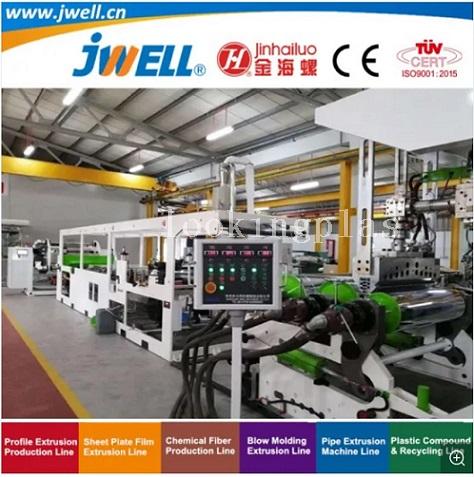| Model | Extruder model | Products thickness(mm) | Main motor power(kw) | Max extrusion Capacity(kg/h) |
| Multi layer | JWE75/40+JWE52/40-1000 | 0.15-1.5mm | 132/15 | 500-600 |
| Single layer | JWE75/40-1000 | 0.15-1.5mm | 160 | 450-550 |
| Highly-efficient | JWE95/44+JWE65/44-1500 | 0.15-1.5mm | 250/75 | 1000-1200 |
Jwell-PLA|PET
Plastic Biodegradable Sheet recycling Making Extruder Machine for Food
Packing|3-D Printing|Garbage Bag|Agricultural Mulch Film
Poly(lactic
acid) or polylactic acid or polylactide (PLA) is a biodegradable and
bioactive thermoplastic aliphaticpolyester derived from renewable
resources, such as corn starch (in the United States and Canada),
cassava roots, chips or starch (mostly in Asia), or sugarcane (in the
rest of the world). In 2010, PLA had the second highest consumption
volume of any bioplastic of the world.
polylactide, polylactic acid, PLA also called polytrimethylenecarbonate;1,3-Dioxan-2-one homopolymer
Producers
have several industrial routes to usable (i.e. high molecular weight)
PLA. Two main monomers are used: lactic acid, and the cyclic di-ester,
lactide. The most common route to PLA is the ring-opening polymerization
of lactide with various metal catalysts (typically tin octoate) in
solution, in the melt, or as a suspension. The metal-catalyzed reaction
tends to cause racemization of the PLA, reducing its stereoregularity
compared to the starting material (usually corn starch).
Another
route to PLA is the direct condensation of lactic acid monomers. This
process needs to be carried out at less than 200 °C; above that
temperature, the entropically favored lactide monomer is generated. This
reaction generates one equivalent of water for every condensation
(esterification) step. The condensation reaction is reversible and
subject to equilibrium, so removal of water is required to generate high
molecular weight species. Water removal by application of a vacuum or
by azeotropic distillation is required to drive the reaction toward
polycondensation. Molecular weights of 130 kDa can be obtained this way.
Even higher molecular weights can be attained by carefully
crystallizing the crude polymer from the melt. Carboxylic acid and
alcohol end groups are thus concentrated in the amorphous region of the
solid polymer, and so they can react. Molecular weights of 128-152 kDa
are obtainable thus.
Polymerization of a racemic mixture of L- and
D-lactides usually leads to the synthesis of poly-DL-lactide (PDLLA),
which is amorphous. Use of stereospecific catalysts can lead to
heterotactic PLA which has been found to show crystallinity. The degree
of crystallinity, and hence many important properties, is largely
controlled by the ratio of D to L enantiomers used, and to a lesser
extent on the type of catalyst used. Apart from lactic acid and lactide,
lactic acid O-carboxyanhydride ("lac-OCA"), a five-membered cyclic
compound has been used academically as well. This compound is more
reactive than lactide, because its polymerization is driven by the loss
of one equivalent of carbon dioxide per equivalent of lactic acid. Water
is not a co-product.








